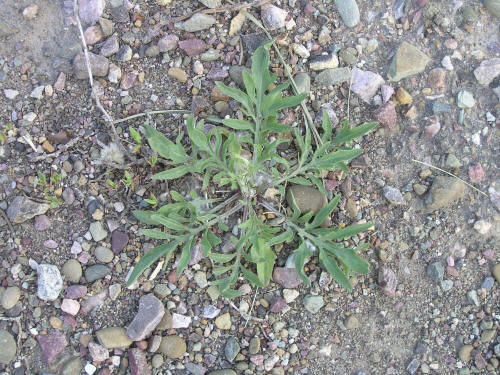Spotted Knapweed
Spotted Knapweed
Centaurea stoebe L.
(synonyms: Centaurea biebersteinii and Centaurea maculosa)
Asteraceae (Sunflower Family)
▲ ▼ seedlings
▲ ▼ rosettes of young plants

▲ ▼ rosettes of young plants
▲ ▼ rosettes of young plants
▲ ▼ first year rosette of compact, deeply lobed leaves

▲ ▼ young plants initiating flowering stems
▲ leaves on stem that will produce flowers
▲ ▼ mature plants with stiff, gray stems, deeply divided gray-green leaves and pinkish-lavender flower heads
▲ flowering (top) and non-flowering (lower front) portions of a spotted knapweed plant
▲ Close up of flowering stems
▲ ▼ flowers
▲ ▼ inflorescence/flowers
▲ flower bud showing characteristic black tips of floral bracts
▲ new shoots from a plant that flowered previous year (example of a perennial spotted knapweed)
Centaurea stoebe L. Spotted Knapweed: (Bayer Code: CENMA; US Code CEST8)
- Biennial weed with grey-green, divided lower leaves, linear upper leaves; basal rosette has deeply divided leaves
- Leaves very hairy with grayish appearance; bracts under inflorescence have dark spots at tips
- Grows 1-4' tall, forming much branched inflorescence structures
- Head flowers are rose-pink, with 30-40 disk flowers per head, about 1 inch diameter, in June-August
- Bracts below inflorescence have purplish-black tip, and are edged with tiny, short, dark spines
- Found on roadsides, pastures, cultivated areas, non-crop areas; needs more moisture than other invasive knapweeds
- Fairly rapidly increasing populations of spotted knapweed in southwest Missouri
- Similar species not yet in Missouri:
- Diffuse knapweed (Centaurea diffusa) has similar basal leaves, but has white flowers and the bracts below the flower head are tan and edged with long, comb-like laterally-spreading spines
- Squarrose knapweed (Centaurea virgata) has somewhat similar leaves to spotted knapweed, but it has tan, comb-like bracts below the head, with bract tips that point away from the head
- Russian knapweed (Acroptilon repens) has more lanceolate leaves with shallow lobing, and papery bracts below the pink-flowered head inflorescence; Russian knapweed is also a creeping perennial, with deep, creeping roots
(Updated January 23, 2019)